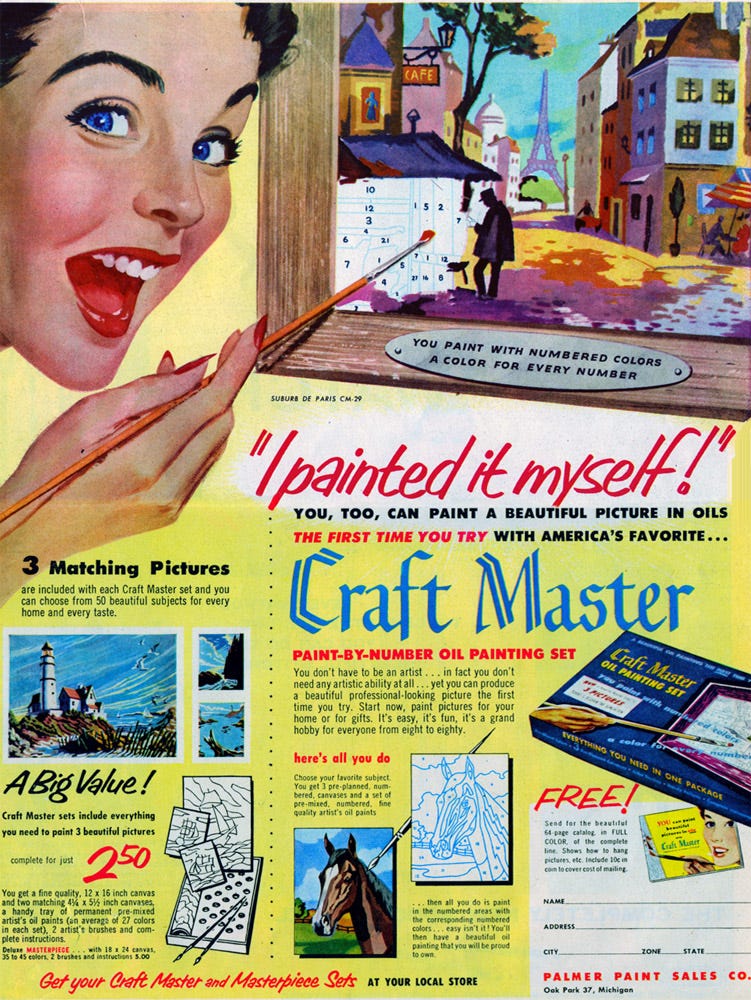Memory, Faulty, Causes of Distortion in
These discoveries were terribly disturbing, because they demonstrated to me that the memories, fabrications, and unrealized desires from my past were in even more of a muddle than I had thought. If I couldn’t separate them from one another, then I really didn’t know any longer who I was. Fabrications from my Personal History, Adventures, Experiences & Observations were invading the territory that had once been held pretty securely by memories from my life. …
Little Follies, “The Fox and the Clam”
TO UNDERSTAND the relationship between experience and imagination, one must be familiar with the paint-by-number canvases that were popular when I was a boy.
Little Follies, “The Fox and the Clam”
It seems to me that my earliest experience with something creates, in my mind, a sketch like the pale blue sketches on those paint-by-number canvases. This sketch then becomes a framework for all my subsequent experiences with similar things. In most of my later life, I’ve been putting paint into the oddly-shaped segments of a picture that I sketched very early. However, as time has gone on, I’ve run out of space on the canvas of experience, and in order to accommodate new experiences I have had to paint over some of the older ones. You can, no doubt, imagine the results. The outline and the earliest experiences are soon obscured. The picture grows more distorted as time passes, at least in the sense that it departs more and more from the original outline. However, since the earlier experiences have been obscured by the later ones, I am forced to rely on memory and on the assumed congruity of the later and earlier experiences to reconstruct the earlier ones, and that reliance has been the source of several illusions.
Little Follies, “The Fox and the Clam”
There is no perception which is not full of memories. With the immediate and present data of our senses we mingle a thousand details out of our past experience. In most cases these memories supplant our actual perceptions, of which we then retain only a few hints, thus using them merely as “signs” that recall to us former images. The convenience and rapidity of perception are bought at this price; but hence also springs every kind of illusion.
The triggering of any set of circuits that results in a set of output responses sufficiently similar to those that were previously adaptive provides the basis for a repeated mental act or physical performance. In this view, memory is dynamically generated from the activity of certain selected subsets of circuits. These subsets are degenerate: A comparison would indicate that different subsets contain circuits that are not the same; nevertheless, activation of any of them can result in a repetition of some particular output. Under these conditions, a given memory cannot be identified uniquely with any single specific set of synaptic changes because the particular synaptic changes associated with a given output and eventually with an entire performance are subject to further change during that performance. So what is called forth when an act is repeated must be any one or more of the neural response patterns adequate to that performance, not some singular sequence or specific detail.
We see that synaptic change is fundamental and essential for memory but is not identical to it. There is no code, only a changing set of circuits corresponding to a given output. The more or less equally effective members of that set of circuits can have widely varying structures. It is this property of degeneracy in neural circuits that allows for changes in particular memories as new experiences and changes in context occur. Memory in a degenerate selectional system is recategorical, not strictly replicative. There is no prior set of determinant codes governing the categories of memory, only the previous population structure of the network, the state of the value systems, and the physical acts carried out at a given moment. The dynamic changes linking one set of circuits to another within the enormously varied neuroanatomical repertoires of the brain allow it to create a memory. . . .
[Dynamic nonrepresentational memory] has properties that allow perception to alter recall and recall to alter perception. It has no fixed capacity limit, since it actually generates “information” by construction. It is robust, dynamic, associative, and adaptive. If our view of memory is correct, in higher organisms every act of perception is, to some degree, an act of creation, and every act of memory is, to some degree, an act of imagination. Biological memory is thus creative and not strictly replicative. It is one of the essential bases of consciousness.Gerald M. Edelman and Giulio Tononi, A Universe of Consciousness: How Matter Becomes Imagination
[more to come on Monday, September 27, 2021]
Have you missed an episode or two or several?
You can catch up by visiting the archive or consulting the index to the Topical Guide.
You can listen to the episodes on the Personal History podcast. Begin at the beginning or scroll through the episodes to find what you’ve missed.
At Apple Books you can download free eBooks of “My Mother Takes a Tumble,” “Do Clams Bite?,” “Life on the Bolotomy,” and “The Static of the Spheres,” the first four novellas in Little Follies.
You’ll find an overview of the entire work in An Introduction to The Personal History, Adventures, Experiences & Observations of Peter Leroy. It’s a pdf document.




My childhood book of stories was Danny Kaye’s Around the World Storybook. My grandmother gave it to me when I was in the second grade. The book was divided by region and each section had a different illustrator. I avoided looking at a picture of a green troll woman with a cleaver because it was too frightening. When I became a professional storyteller I retold many of the stories from the Danny Kaye book.